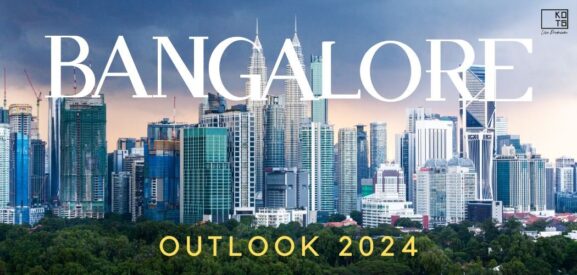DLF: A Marvel of Indian Commercial & Residential Infrastructure

Destiny often unfolds itself when you least expect it to do so. For DLF chairman Kushal Pal Singh, it was under a fierce sun on May 12, 1981, in the wilderness beyond Delhi called Gurgaon, with just two keekar trees for shade and a deep well to quench his thirst.
Singh had been sitting all by himself on a cot next to the well when a Jeep stopped as its engine had got overheated and the driver was looking for some water to cool it. In the Jeep was Rajiv Gandhi, who had just entered politics and had big dreams to fast-track India to the 21st century.
Delhi Land & Finance, or DLF, a company set up by Singh’s father-in-law, Chaudhary Raghvendra Singh, had developed no fewer than 21 colonies in Delhi between 1947 and 1961, when all development in the capital city was taken over by the Delhi Development Authority. That had forced DLF to diversify into batteries, cables and so on. Twenty years later, on this blistering summer afternoon, Singh still nurtured hopes of getting back into township development.
The two men got chatting under the trees and a couple of hours later, Gandhi was convinced that the laws constraining the sector needed to be liberalised. “It was a turning point for not just DLF but also for urban development in the country,” Singh remembers 25 years later at The Chambers, the exclusive club at the Taj Man Singh hotel.
DLF has definitely come a long way since then – from townships, shopping malls and commercial space to hotels, special economic zones and infrastructure projects. At the moment, DLF has invested close to Rs 80,000 crore (Rs 800 billion) in projects running into 100 million square feet. “We are not aware of any developer in the world who has undertaken work of this magnitude,” says Singh, sipping nimbu pani from a tall glass.

Singh hasn’t done too badly either. His flagship, DLF Universal, is all set to offload 10 per cent in its IPO for Rs 10,000 crore (Rs 100 billion). As Singh personally owns the rest of the stock, his fortune is worth $20 billion – below L N Mittal’s $23.5 billion, but the same as Prince Alwaleed Bin Talal Alsaud of Saudi Arabia and higher than Li ka-shing’s $18.8 billion and Michael Dell’s $17.1 billion. Watch out for the next Forbes’ list of billionaires – Singh is sure to leapfrog amongst the top dozen or so from number 114 this year. Not for nothing, Singh’s father-in-law would often expand DLF to Damn Lucky Fellow!
Singh is 74 but his tall frame is ramrod straight. Dressed in a deep blue blazer and a red tie, there is something military about his bearing. Singh tells a long story when I ask him about his days of wearing olive green. While studying for aeronautical engineering in England, Singh’s fondness for polo led him to the Indian Military Academy. But the tough regimen of the academy did not agree with him and he was all set to run away.
“I can help you run away but can do nothing when you will be called a bhagora (deserter) for the rest of your life,” the commandant told the young cadet when he came to know about his designs. Singh got the message. He passed out with the sword of honour and served nine years with the Deccan Horse.
From tanks to houses. “How did you discover Gurgaon?” I want to know. “Right from the Mughal times, Delhi has expanded towards the south: From Chandni Chowk to Daryaganj, Connaught Place, Lutyen’s Delhi, Greater Kailash and so on. So, we thought Gurgaon was the next logical extension,” Singh answers as we move on to the dining table for sumptuous Indian fare.
However, so as to make people feel it was not a distant suburb of the city, DLF cleverly called its first project Qutab Enclave after the historical monument in south Delhi. Still, there were few takers for Gurgaon in the 1980s. Then destiny gave another helping hand to Singh. Enter Jack Welch.
Rajiv Gandhi had invited the charismatic CEO of GE to India. But Welch was reluctant. “I had known him for a while. So, I spoke to him and he agreed to come,” says Singh, as we are served delicious carrot soup. While in India, Welch was struck by the country’s trained manpower and started thinking in terms of outsourcing back office work to India.
From DLF’s point of view, the visit was no less important. Welch decided to set up GE’s first office at Gurgaon. Others were quick to follow. Almost overnight, Gurgaon had turned from a sleepy village to a throbbing hub of commercial activity. Singh, who had put his money on Gurgaon, was soon riding the gravy train.
And now, he plans to unlock the value by going public. “Why aren’t you going for private equity or a strategic partner?” I am curious, as we are served dal, rice, cauliflower and raita. (This being the age of bird flu, both of us say no to chicken curry.)
Singh’s answer is cocky, yet practical: “We still have several offers. But what expertise do foreign players bring to the table? Doing business in India requires a special expertise, which nobody has better than us. They will only ride on our brand. A strategic partner will bind us to one set of architects and planners. At the moment, we are hiring the best people in the world.”
As we are served dessert, I ask him what succession plans has he drawn up. “A majority of the shares will go to my son, Rajive, though my two daughters will also get some shares. To be successful, it is important there should be only one leader,” he says.
Damn lucky fellow, I tell myself.




